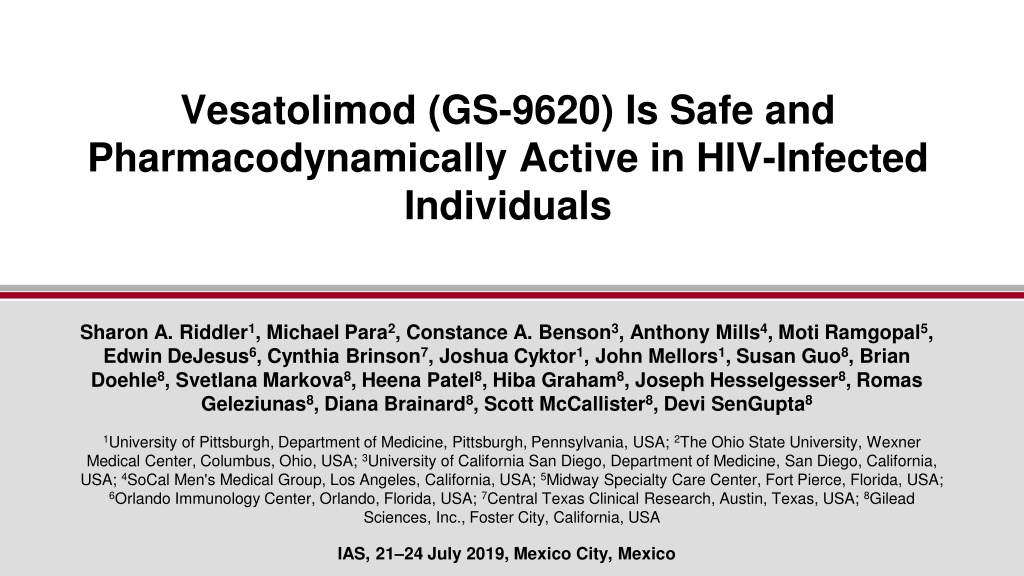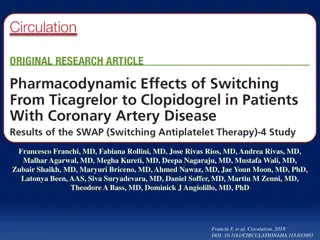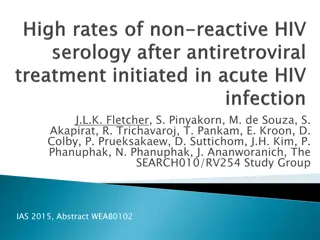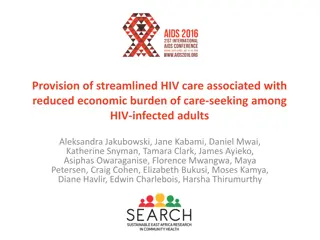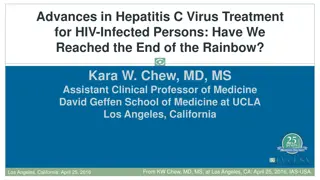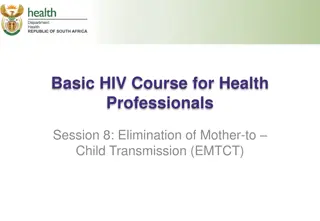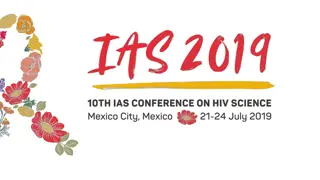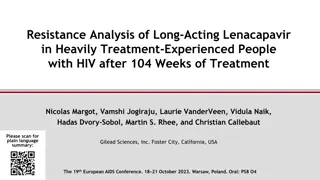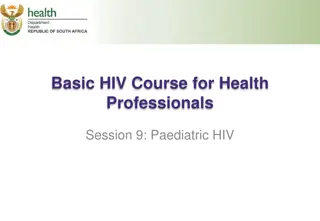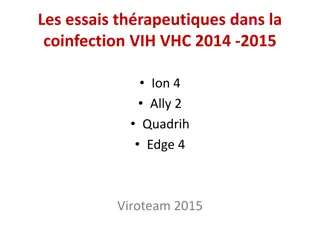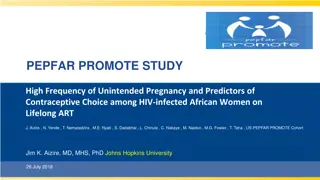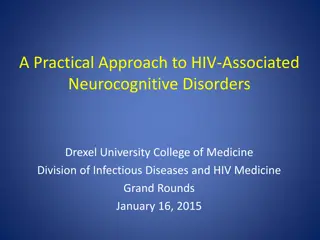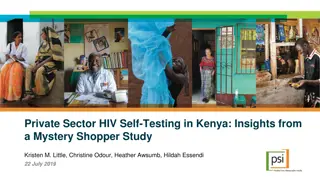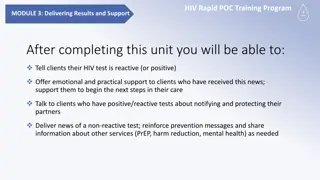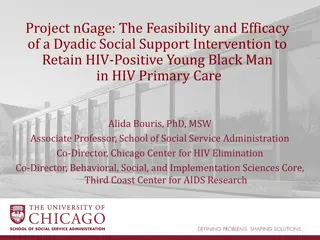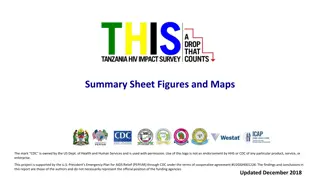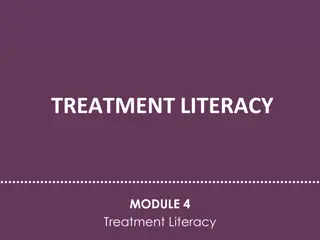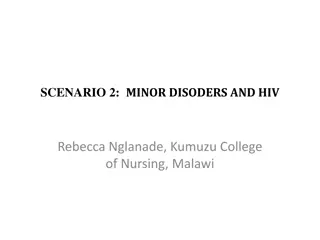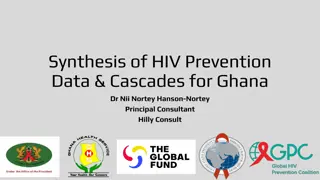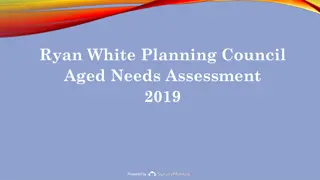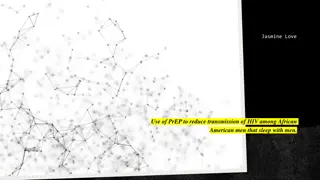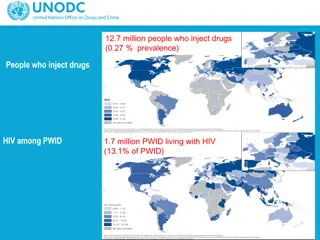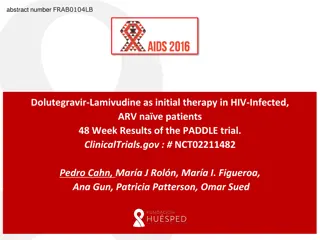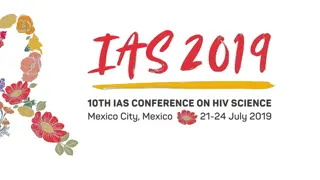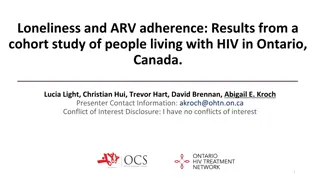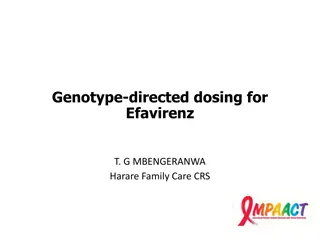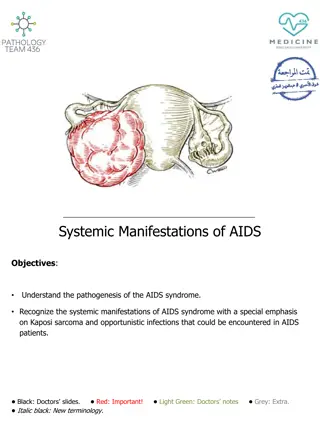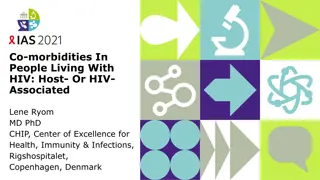Safety and Pharmacodynamic Activity of Vesatolimod (GS-9620) in HIV-Infected Individuals
Vesatolimod (GS-9620) has shown to be safe and pharmacodynamically active in individuals infected with HIV. Studies demonstrate its potential to eliminate and activate infected CD4 T cells, recruit immune cells like NK cells and macrophages, and work in combination with broadly neutralizing antibodies and therapeutic vaccines to potentially reduce HIV reservoirs. Vesatolimod also shows promise in nonhuman primate models and ongoing dose escalation studies in People Living With HIV (PLWH) are focused on safety and various parameters including virology and immune responses.
Download Presentation

Please find below an Image/Link to download the presentation.
The content on the website is provided AS IS for your information and personal use only. It may not be sold, licensed, or shared on other websites without obtaining consent from the author. Download presentation by click this link. If you encounter any issues during the download, it is possible that the publisher has removed the file from their server.
E N D
Presentation Transcript
Vesatolimod (GS-9620) Is Safe and Pharmacodynamically Active in HIV-Infected Individuals Sharon A. Riddler1, Michael Para2, Constance A. Benson3, Anthony Mills4, Moti Ramgopal5, Edwin DeJesus6, Cynthia Brinson7, Joshua Cyktor1, John Mellors1, Susan Guo8, Brian Doehle8, Svetlana Markova8, Heena Patel8, Hiba Graham8, Joseph Hesselgesser8, Romas Geleziunas8, Diana Brainard8, Scott McCallister8, Devi SenGupta8 1University of Pittsburgh, Department of Medicine, Pittsburgh, Pennsylvania, USA; 2The Ohio State University, Wexner Medical Center, Columbus, Ohio, USA; 3University of California San Diego, Department of Medicine, San Diego, California, USA; 4SoCal Men's Medical Group, Los Angeles, California, USA; 5Midway Specialty Care Center, Fort Pierce, Florida, USA; 6Orlando Immunology Center, Orlando, Florida, USA; 7Central Texas Clinical Research, Austin, Texas, USA; 8Gilead Sciences, Inc., Foster City, California, USA IAS, 21 24 July 2019, Mexico City, Mexico
Disclosures Dr. Riddler has received grant support from Gilead (for the current project) and GlaxoSmithKline. 2
Immune-Based Strategies to Eliminate HIV Reservoirs Protect ART Vesatolimod (TLR7 agonist) Eliminate Activate Infected CD4 T cells Vaccines bNAb Vesatolimod (TLR7 agonist) Recruit immune cells NK cells M s T cells Combine TLR7 agonist, bNAbs, therapeutic vaccine Goal ART, antiretroviral therapy; bNAb, broadly neutralizing antibody; M s, macrophages; NK, natural killer; TLR7, toll-like receptor-7. 3
Proof of Concept in Nonhuman Primate Model TLR7 + bNAb TLR7 + Vaccine 7 7 Log SHIV RNA Copies/mL Log SIV RNA Copies/mL 6 6 3/9 Controllers 5/11 No Rebound 5 5 4 4 3 3 2 2 0 20 40 60 80 100 120 140 160 80 100 120 140 160 0 20 Days following ART discontinuation 40 60 Days following ART discontinuation Modified from Borducchi E, et al. Nature 2018;563:360-4. Modified from Borducchi E, et al. Nature 2016;540:284-7. SHIV, simian/human immunodeficiency virus; SIV, simian immunodeficiency virus. 4
Vesatolimod Dose Escalation Study in PLWH 1 mg x 6 2 mg x 6 4 mg x 6 6 mg x 10 8 mg x 10 Randomized 6:2 PLWH on ART N=48 VES:PBO PO, fasted Every other week 10 mg x 3 12 mg x 7 doses Key inclusion criteria: CD4 count 400 cells/ L HIV-1 RNA levels <50 copies/mL x 1 year Pre-ART CD4 nadir 200 cells/ L Objectives: Safety, PK PD parameters: ISG, cytokines, cell activation Virology: Plasma HIV RNA NCT02858401 PLWH: People Living with HIV; ISG, interferon-stimulated gene; PBO, placebo; PD, pharmacodynamics; PK, pharmacokinetics; VES, vesatolimod. 5
Vesatolimod Dose Escalation: Design and Assessments 1 2 3 4 5 6 7 8 9 10 11 12 13 14 15 16 17 18 19 20 21 22 Week VES Dosing + ART VES 1, 2, 4 mg x 6 doses VES 6, 8, 10/12 mg cohort x 10 doses CD4, Plasma HIV-1 RNA HIV DNA, ELISpot*, flow* ISG, cytokines, cell activation VES PK *Measurement of HIV specific T-cell responses 6
Baseline Demographic and Disease Characteristics PBO n=12 47 (26-62) 1 mg n=6 46 (28-58) 2 mg n=6 45 (27-58) 4 mg n=6 54 (43-57) 6 mg n=6 45 (28-55) 8 mg n=6 45 (31-60) 10/12 mg n=6 53 (23-66) Median age, y (range) Male, n 12 6 5 6 6 3 5 Median CD4, cells/mm3 624 875 658 504 757 676 814 Median time from Dx to ART, y 1 3 6 2 1 2 1 Median total time on ART, y 10 5 6 11 5 4 14 Median Pre-ART VL (log10 copies/mL) 5.34 4.35 4.64 4.48 5.17 3.48 4.01 Dx, diagnosis. 7
Safety Slide 8
Overall Safety PBO n=12 1 mg n=6 2 mg n=6 4 mg n=6 6 mg n=6 8 mg n=6 10/12 mg n=6 Participants, n (%) Any grade AE 9 (75) 4 (67) 4 (67) 2 (33) 4 (67) 5 (83) 4 (67) Grade 2 2 (17) 3 (50) 2 (33) 1 (17) 1 (17) 2 (33) 1 (17) Study drug- related AE 2 (17) 0 1 (17) 1 (17) 1 (17) 3 (50) 3 (50) 1 Grade 3 AE (abdominal pain) and 1 serious AE (diverticulitis; 2 mg cohort) Both unrelated to study drug and occurring in same participant No discontinuations due to AEs; no Grade 4 AEs; no deaths 9
Common Adverse Events (> 1 participant by cohort) PBO n=12 1 mg n=6 2 mg n=6 4 mg n=6 6 mg n=6 8 mg n=6 10/12 mg n=6 Participants, n (%) Any AE 9 (75) 4 (67) 4 (67) 2 (33) 4 (67) 5 (83) 4 (67) Cough 3 (25) 1 (17) 0 1 (17) 1 (17) 0 0 Headache 2 (17) 1 (17) 1 (17) 0 0 1 (17) 1 (17) Fatigue 3 (25) 2 (33) 0 1 (17) 1 (17) 0 3 (50) Nausea 1 (8) 2 (33) 1 (17) 0 0 1 (17) 1 (17) Myalgia 1 (8) 0 0 0 2 (33) 1 (17) 1 (17) Sinus Congestion 1 (8) 2 (33) 1 (17) 0 1 (17) 0 0 URI 0 0 0 0 0 2 (33) 0 URI: upper respiratory tract infection 10
Laboratory Abnormalities PBO n=12 1 mg n=6 2 mg n=6 4 mg n=6 6 mg n=6 8 mg n=6 10/12 mg n=6 Participants, n (%) Grade 1 7 (58) 5 (83) 5 (83) 3 (50) 3 (50) 3 (50) 3(50) Grade 2 2 (17) 1 (17) 0 1 (17) 2 (33) 2 (33) 1 (17) Grade 3 0 0 0 0 0 0 1 (17)a Grade 4 0 0 0 0 0 1 (17)b 1 (17)b Participants were counted once for the maximum severity for each laboratory test. a Participant with hematuria with confirmed menses; b Participantswith elevated creatinine kinase due to strenuous exercise No dose dependent trends in lab abnormalities 11
Pharmacokinetics Slide 12
Pharmacokinetics 100000 1 mg 10000 concentration, pg/mL 2 mg 4 mg VES plasma 1000 6 mg VES 8 mg * 100 10 mg 12 mg 10 0 4 8 12 16 20 24 28 32 36 40 44 48 Time, h VES was rapidly absorbed (Tmax 1-4 hours) Exposure was generally dose proportional *Below limit of quantification at 48 hours 13
Pharmacodynamics Slide 14
NK Cell Activation Placebo 6 m g 8 m g 10 m g 12 m g 60 60 60 60 60 NK Cells CD69+, % 40 40 40 40 40 20 20 20 20 20 0 0 0 0 0 24 hours 48 hours Predose 24 hours 48 hours 24 hours 48 hours 24 hours 48 hours 24 hours 48 hours P redose P redose P redose P redose 1st administration at each dose level shown Similar trends observed in CD4 and CD8 T lymphocytes 15
Circulating Cytokines IL-1RA IP-10 ITAC 6 mg 8 mg 10 mg 12 mg Dose 1 Dose 5 Dose 10 Dose 1 Dose 5 Dose 10 Dose 1 Dose 5 Dose 10 Median Induction, pg/mL (IQR) 10000 10000 10000 Absolute Change 1000 1000 1000 100 100 100 10 10 10 0 3 6 9 57 60 63 129 132 135 1 0 3 6 9 57 60 63 129 132 135 1 0 3 6 9 57 60 63 129 132 135 1 Days Days Days IL-1RA, interleukin 1 receptor antagonist; IP-10, IFN gamma-induced protein 10; ITAC, IFN-inducible T-cell- chemoattractant 16
Induction of ISG15 mRNA Participants, n=36 1 2 3 4 5 6 Dose 10 4 3 1 10/12 mg >50 >50 >50 1 2 3 4 5 6 10 8 mg ISG15 fold change (by cohort) >50 5 1 >50 10-<50 10-<50 >50 10-<50 1 2 3 4 5 6 10 >50 6 mg 5 1 10-<50 10-<50 2.5-<10 2.5-<10 10-<50 2.5-<10 1 2 3 4 5 6 6 4 1 4 mg 10-<50 1 2 3 4 5 6 2.5-<10 6 4 1 2.5-<10 <2.5 <2.5 2.5-<10 <2.5 2 mg 2.5-<10 1 2 3 4 5 6 6 4 1 <2.5 1 mg <2.5 <2.5 <2.5 Placebo White cells are missing data ISG, Interferon-stimulated gene 17
Virologic Assessments Slide 18
Virologic Results PBO n=12 1 mg n=6 2 mg n=6 4 mg n=6 6 mg n=6 8 mg n=6 10/12 mg n=6 Any pVL > 20 copies/mL, n 8 2 1 2 1 0 3 pVL range, copies/mL 21-2430 21 42 21 23 69 32 - 24 27 Most occurrences of plasma viral load elevations > 20 copies/mL were isolated No evidence of changes in plasma HIV RNA by single copy assay, or in total cell-associated HIV DNA or HIV RNA pVL, plasma viral load. 19
Conclusions In this placebo controlled, phase 1 study in PLWH: Multiple doses of VES 1-12 mg were well tolerated Plasma exposure of VES was generally dose proportional Immune stimulation was evident at 6 mg doses Cellular activation markers, plasma cytokine increases and ISG mRNA induction No obvious changes in virologic markers Trials evaluating the efficacy of VES, alone and in combination with other agents, are in progress 20
Acknowledgments We extend our thanks to the study participants and investigators. This study was funded by Gilead Sciences Inc. 21
